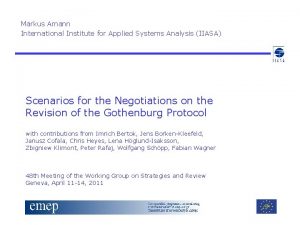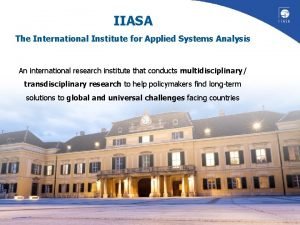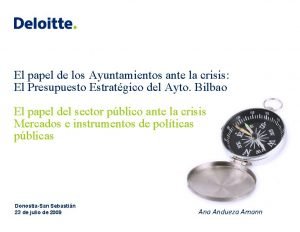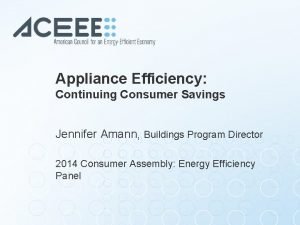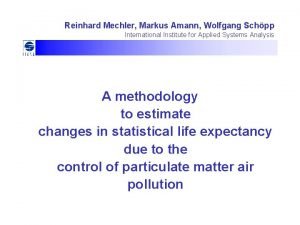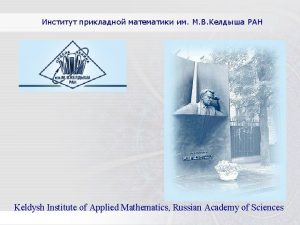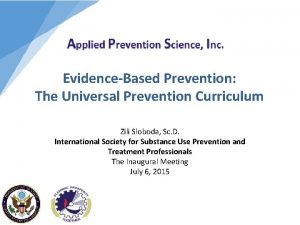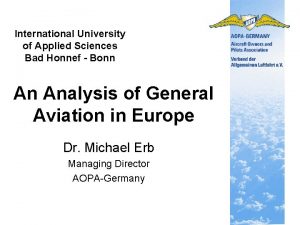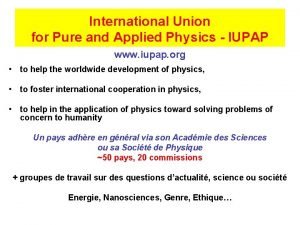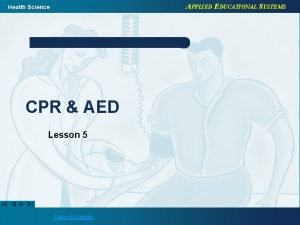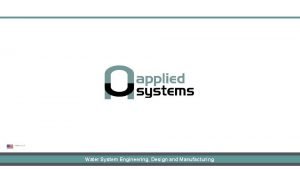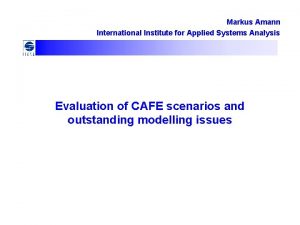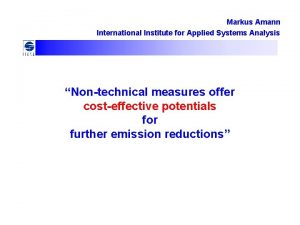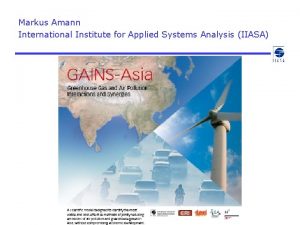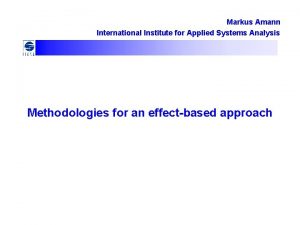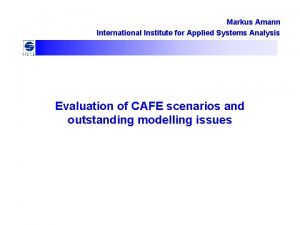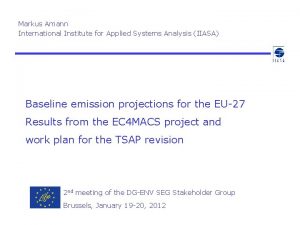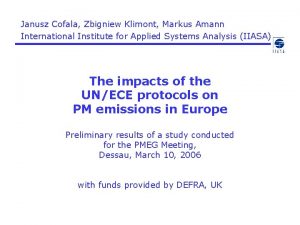Markus Amann International Institute for Applied Systems Analysis












- Slides: 12

Markus Amann International Institute for Applied Systems Analysis (IIASA) Baseline emission projections for the EU-27 Results from the EC 4 MACS project and work plan for the TSAP revision 2 nd meeting of the DG-ENV SEG Stakeholder Group Brussels, January 19 -20, 2012

The EC 4 MACS baseline emission projection PRIMES REF 2010 + CAPRI 2010 scenarios • EC 4 MACS employs recent EU-wide consistent activity projections (i. e. , PRIMES 2010, CAPRI) • EC 4 MACS assumes compliance with EU climate and renewable targets (i. e. , PRIMES 2010), and current air pollution control legislation • -13% GHGs in 2020, -17% GHGs in 2030 relative to 2005 • NH 3 would increase by ~7% • Other air pollutants decrease, even after 2020 • In 2020, the baseline would meet TSAP targets for PM, ozone and acidification, but not for eutrophication

Uncertainties of baseline emission projections: Comparison with national scenarios provided in 2010 to CLRTAP SO 2 NOx VOC PM 2. 5 NH 3 Main reason for differences: • Assumptions on activity projections • Assumed efficiency of emission controls • Changes in official emission inventories

Different assumptions on climate and energy policies result in different SO 2 and NOx emissions SO 2 GHGs NOx • National scenarios with higher SO 2 and NOx assume also higher GHG emissions (+4% in 2020 relative to 2005) • PRIMES 2010 CLE: -13% GHGs rel. to 2005, compliant with EU E&C package • PRIMES -25% CLE: -18% GHGs in 2020, even lower SO 2 and NOx

National activity scenarios build on different assumptions GDP and oil price assumptions of the national scenarios provided to IIASA for the Gothenburg negotiations Assumed GDP development to 2020 The national activity scenarios provided to IIASA in 2010 employ internationally inconsistent assumptions on World oil prices assumed for 2020 in the national scenarios • economic growth, • oil prices, • carbon prices/climate policies • import/export of electricity, • etc. . These differences will influence baseline emissions and the cost-effective allocation of further emission control measures across countries

Different assumptions on agricultural activities result in different NH 3 emissions • • • EC 4 MACS sensitivity analysis for ‘healthy diet’: – Original assumption: -75% meat consumption, no change in milk demand – Coupled milk-meat production and feedback from lower meat prices lead to: • -25% chicken • -75% pigs • -10% cattle • Total meat consumption: -33% Emission changes in 2030 (relative to baseline): – -17% NH 3 – -9% CH 4 – -6% N 2 O Larger emission reductions would require changes in milk consumption

Sensitivity analysis for transport emissions Implications of hypothetical non-delivery of Euro-5 and Euro-6 EC 4 MACS sensitivity analyses for implementation failure of Euro 5/6: In 2020, • (observed) real-life Euro-5 emission factors would increase total NOx by 16% compared to EC 4 MACS baseline, • failure of Euro-6 could increase total NOx emissions by up to 50%. Some countries assume failure of Euro-6 in their Gothenburg pledges For comparison, a 50% lower diesel fraction of passenger cars would reduce total NOx emissions by 2 -7 %.

Uncertainties from emission inventories Difference in 2005 emissions reported by MS in 2012 (CION) and 2011 (EMEP)

The way forward to reduce discrepancies between national and EU-wide estimates: Bilateral consultations on baselines • February: – Report and on-line access to Final EC 4 MACS baseline emission scenario • March-September: – Bilateral consultations with MS experts on GAINS emission calculations (but not on energy scenarios!) to improve the EC 4 MACS Final Assessment – For appointments: contact IIASA – Submission of national energy/agricultural scenarios to IIASA for implementation in GAINS data templates with PRIMES data will be provided by IIASA. • March-September: – New PRIMES 2012 baseline, with consultations of DG-ENER/PRIMES with MS energy experts • June: – Draft TSAP baseline (including first MS comments) presented to ESG – Further feedbacks to IIASA up to September • December 2012: – Final TSAP baseline(s)

Scope for further emission reductions Maximum Control Efforts scenario SO 2 NOx PM 2. 5 NH 3 VOC

Forthcoming reports under the Service contract to explore sectorial emission reduction potentials Reports: 1. Draft emission baseline up to 2030 and Maximum Control Efforts scenario 2. Comparison of NEC assumptions in 2000 with actual developments, reasons for differences 3. Contribution to EU air quality from non-EU countries 4. Further emission reduction potentials from small emission sources 5. Further emission reduction potentials from agricultural sources 6. Further emission reduction potentials from ships 7. Further emission reduction potentials from road traffic 8. Compliance with air quality limit values (downscaling methodology – see next talk) Time table: • June: – Presentation of draft reports to SEG • September: – Deadline for feedbacks • December: – Final version of reports – Incorporation into the Final TSAP baseline

Conclusions • The EC 4 MACS baseline, based on PRIMES/CAPRI 2010, suggests increases of NH 3 and declines of SO 2, NOx, PM 2. 5 and VOC. TSAP targets would be met, with the exception for eutrophication • National energy scenarios highlight important uncertainties related to – different assumptions on energy and climate policies (national projections not necessarily internationally consistent), – different expectations about effectiveness of current emission control policies (e. g. , transport), – recent changes in historic emission inventories (validation? ). • The work plan for the TSAP revision foresees bilateral consultations of MS and IIASA/DG-ENER to resolve key discrepancies. Final baseline scenarios are planned for end of 2012.
 Markus amann
Markus amann International institute for applied system analysis
International institute for applied system analysis Ana andueza amann
Ana andueza amann Amann appliances
Amann appliances Schpp
Schpp Elearning adveti
Elearning adveti Keldysh institute of applied mathematics
Keldysh institute of applied mathematics Applied prevention science international
Applied prevention science international International university of applied sciences bad honnef
International university of applied sciences bad honnef Iupap
Iupap Allusions in the book thief
Allusions in the book thief Applied education systems
Applied education systems Applied systems inc subsidiaries
Applied systems inc subsidiaries
